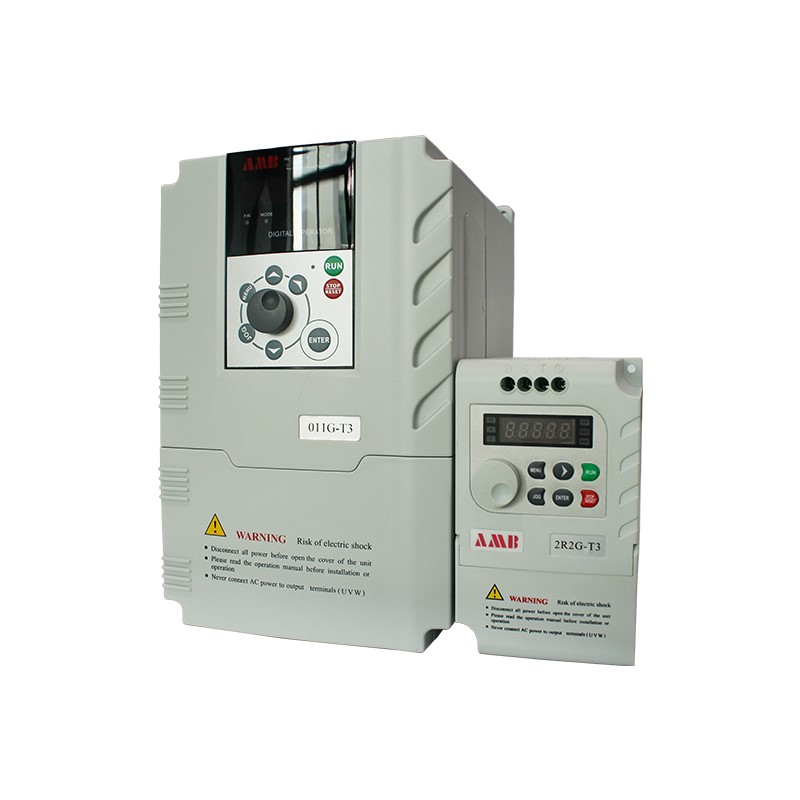
In today's rapid development of science and technology, with the continuous improvement of industrial automation, inverter has been widely used. It is very important to choose a suitable frequency converter for the normal and efficient work of the frequency converter. However, in the actual use, we should pay attention to some misunderstandings.
Error 1: connect electromagnetic switch and electromagnetic contactor in inverter output circuit
In practical application, some occasions need to use the contactor to switch the frequency converter: for example, when the frequency conversion fault is switched to the power frequency state, or when one motor fails, the frequency converter turns to drive another motor and so on. Therefore, many users will think that it is a standard configuration to install electromagnetic switch and electromagnetic contactor in the inverter output circuit, which is a safe way to disconnect the power supply. In fact, there are great hidden dangers in this practice.
Disadvantages: when the frequency converter is still in operation, the contactor is first disconnected, and the load is suddenly interrupted. The surge current will make the over-current protection act, which will have a certain impact on the rectifier inverter main circuit. Serious, even make inverter output module IGBT damage. At the same time, when the inductive motor is loaded, the inductive magnetic field energy can not be released quickly, which will produce high voltage and damage the insulation of motor and connecting cable.
Coping strategy: connect the inverter output side with the motor cable directly. The normal start and stop of the motor can be realized by triggering the inverter control terminal, so as to achieve the effect of soft start and soft stop. If the contactor must be used at the output side of the frequency converter, the necessary control interlock must be carried out between the output of the frequency converter and the action of the contactor, so as to ensure that the contactor can act only when there is no output of the frequency converter.
Error 2: when the equipment is out of service, disconnect the AC input power of the inverter
In the normal shutdown of the equipment, many users are used to disconnect the AC input power switch of the inverter, thinking that it is safer and can save energy.
Disadvantages: this approach, on the surface, seems to be able to protect the inverter from the impact of power failure. In fact, the inverter is not charged for a long time, plus the influence of the environmental humidity on the site, which will cause the internal circuit board to be damped and slowly oxidize and gradually appear short circuit phenomenon. This is the reason why soft faults are frequently reported when the inverter is powered off for a period of time.
Coping strategy: in addition to equipment maintenance, the frequency converter should be kept in a state of electrification for a long time. In addition, the upper and lower fans of the frequency conversion control cabinet should be turned on, desiccant should be placed in the cabinet or automatic temperature and humidity control heater should be installed to maintain ventilation and dry environment.
Error 3: frequency converter control cabinet installed in open air or dust environment adopts sealed type
In some factories, mines, basements, outdoor installation and use of inverter control cabinet, will withstand such as high temperature, dust, humidity and other harsh environment. For this reason, many users will choose sealed type frequency conversion cabinet. Although to a certain extent, this can play a rain proof, dust-proof effect, but also brings the problem of poor heat dissipation of the inverter.
Disadvantages: the tight sealing of the control cabinet will cause overheating of internal components due to insufficient ventilation and heat dissipation capacity of frequency converter, and the protection action of thermal sensitive element will cause fault trip and forced shutdown of equipment.
Coping strategy: the upper part of the inverter control cabinet is equipped with a breathable rain cover with dust-proof filter screen as the exhaust port. The lower part is also slotted to install the fan with filter screen as the air inlet. It can form air circulation and filter dust in the environment at the same time. Cooling air flow direction: from bottom to top. The transverse installation distance between frequency converters shall not be less than 5mm, and the temperature of cooling air entering the frequency converter shall not exceed + 40 ℃. If the ambient temperature is above + 40 ℃ for a long time, the inverter should be installed in a small room with air conditioning.
In the control box, the frequency converter should be installed in the upper part of the box. It is absolutely not allowed to install the heating element or easily heating element close to the bottom of the converter.
Error 4: in order to improve the voltage quality, parallel power factor compensation capacitors are connected at the output end of frequency converter
Due to the limitation of power consumption capacity, the voltage quality of some enterprises can not be guaranteed, especially when the large-scale electrical equipment is put into operation, the bus voltage in the station will be reduced, and the load power factor will obviously decrease. In order to improve the voltage quality, the user usually parallels the power factor compensation capacitor at the inverter output end, hoping to improve the motor power factor.
Disadvantages: connecting the power factor compensation capacitor and surge absorber to the motor cable (between the drive unit and the motor), their influence will not only reduce the control accuracy of the motor, but also form transient voltage at the output side of the drive unit, causing permanent damage to the ACS800 drive unit. If the power factor compensation capacitor is paralleled on the three-phase input line of ACS800, it must be ensured that the capacitor and ACS800 will not be charged at the same time, so as to avoid damaging the inverter by surge voltage. The current of the frequency converter flows into the capacitor used to improve the power factor, which can not be started because of the over current (OCT) of the converter caused by its charging current.
Coping strategy: remove the capacitor and operate. As for improving power factor, it is effective to connect AC reactor at the input side of frequency converter.
Mistake 5: circuit breaker is better than fuse for thermal overload and short circuit protection of frequency converter
Circuit breaker with perfect protection function has been widely used in power distribution equipment, which will replace the traditional fuse. Now many manufacturers produce complete sets of frequency control equipment, basically equipped with circuit breakers (air switches), in fact, there are some security risks.
Disadvantages: when the power cable has a short circuit fault, the protection action trip of the circuit breaker will delay due to the inherent action time of the circuit breaker itself. During this period, the short-circuit current will be introduced into the inverter, causing component damage.
Coping strategy: as long as the cable is selected according to the rated current, the inverter drive unit can protect itself, the input end and the motor cable to prevent thermal overload without additional thermal overload protection equipment. The configuration of fuse will protect the input cable in case of short circuit, reduce device damage and prevent damage to connected equipment in case of internal short circuit of transmission device.
Check that the action time of the configured fuse should be less than 0. Five seconds. The action time depends on the type of fuse (GG or AR), the impedance of the supply network, the cross-sectional area of the power cable, material and length. When the use of GG fuse exceeds 0. When the action time is 5 seconds, the fast melting (AR) can reduce the action time to an acceptable level in most cases. Fuses must be of the non delay type.
Circuit breakers do not provide fast enough protection for transmission equipment because they react more slowly than fuses. Therefore, fuses should be used instead of circuit breakers when quick protection is needed.
Error 6: only the load power should be considered in the selection of frequency converter
When purchasing frequency converters, many users usually match the capacity of frequency converters only according to the power of driving motor. In fact, the load driven by the motor is not the same, and the requirements for frequency converter are also different.
Disadvantages: due to the different load characteristics of the motor, if the comprehensive factors are not fully considered, the frequency converter may be damaged due to improper use. At the same time, the safety risk may be caused due to the lack of necessary brake unit and filter.
Coping strategy: according to the characteristics and types of load, the capacity and configuration of frequency converter should be selected reasonably.
1. Fans and pumps are the most common loads: the requirements for frequency converter are the simplest, as long as the capacity of frequency converter is equal to the capacity of motor (the capacity of air compressor, deep water pump, sediment pump and rapidly changing music fountain needs to be increased).
2. Crane load: the characteristic of this kind of load is that the impact is very big when starting, so the inverter is required to have a certain margin. At the same time, there will be energy feedback when the weight is lowered, so the brake unit or the common bus should be used.
3. Uneven load: some loads are sometimes light and sometimes heavy. At this time, the capacity of frequency converter should be selected according to the situation of heavy load, such as rolling mill machinery, crushing machinery, mixer, etc.
4. Large inertia load: such as centrifuge, punch press, rotary kiln of cement plant. Such load has large inertia, so it may vibrate when starting, and energy feedback will be provided when motor decelerates The frequency converter with larger capacity should be used to speed up the starting and avoid oscillation. Cooperate with brake unit to eliminate feedback electric energy.
With the cooperation of other intelligent devices (PLC and DCS), the inverter can realize multiple control strategies and closed-loop regulation, and it has perfect protection function. But in practice, there are many misunderstandings. Facing up to the contradiction, avoiding the risk and using reasonably are the key to improve the efficiency and service life of frequency converter and reduce unnecessary loss.

|
|

|
| The public, | Mobile station |
 0755-81719517
0755-81719517
|
|
 0755-81719530 0755-81719530 |
 [email protected] [email protected] |
 Floor 1, 5 and 6, building 7, lijincheng science and technology industrial park, gongye dong road, longhua new district, shenzhen Floor 1, 5 and 6, building 7, lijincheng science and technology industrial park, gongye dong road, longhua new district, shenzhen |
|